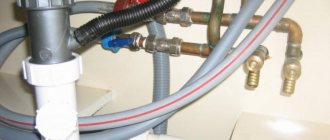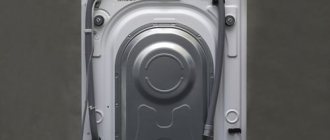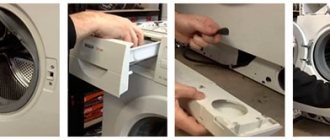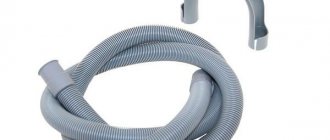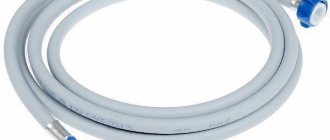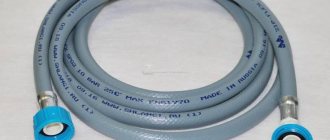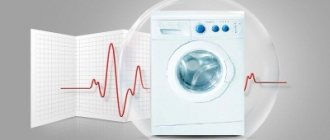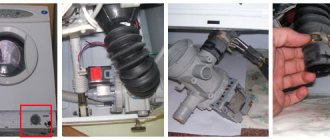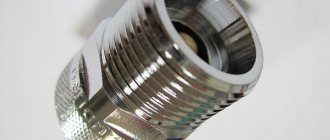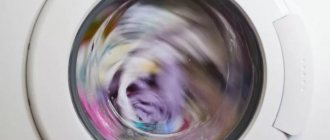The correct operation of household appliances and the duration of their operation largely depend on their correct installation and connection. This is especially true for automatic and semi-automatic washing machines. This article will tell you how to independently and correctly install the drain hose of a washing machine to ensure normal discharge of dirty water into the sewer system.
Adapters for washing machine to sewer and water
Has the equipment been purchased and delivered to your home?
Great, but now there is a need for installation and connection. A correctly selected adapter for a washing machine will help you easily connect the device to the water and drain. Situations vary, as does the distance from the washing machine to the nearest utilities. Therefore, to connect the machine to the water supply, an adapter with a shut-off valve and a 1/2 or 3/4 thread may be useful. The connector will serve as an extension cord, which will allow communications to be connected to the sewer. What types of adapters are there for a washing machine?
Simple designs
Simple products have a primitive and understandable design. These are plastic or brass elements that have one inlet and outlet, but the thread diameter may differ from different sides. They are used for an inlet hose or under a drain, especially in cases where it is necessary to increase the length of the hose.
What types of water adapters are there:
- Plastic with external thread 3/4 or 1/2. To be more precise, the part is made of polyethylene. It is inexpensive and perfectly holds together drain and fill elements.
- Brass fittings or fittings for water supply. Brass parts have rightfully earned the role of durable and reliable pipe connectors. They are easy to process and have both internal and external threads. Everything you need to do to attach the hose and screw the structure into the pipe section.
- Nickel-plated brass drains can also be attached to the inlet hose. Select the diameter in accordance with the connections. A hose is attached to one side, the other is screwed into a threaded pipe. Serve up to 15 years.
- Clamps for cutting into pipes. Polyethylene clamps can withstand pressure up to 10 bar. Allows you to quickly cut into the water supply without dismantling. The device is secured with bolts, rubber sealing ensures tightness.
Related article: Pump for draining water from a washing machine
- Adapters for hose with filter. The simple design has a built-in mesh filter that prevents small debris, rust, and sand from entering the machine.
Such devices are often used to connect the washing machine to the water supply and drain. The elements are inexpensive and easy to install even for a novice amateur.
Complex designs
Drain and fill adapters can have three or more outlets. This allows you to solve several problems at once regarding connecting both a washing machine and other equipment. Such devices can be equipped with taps, which allows you to turn off the water in a timely manner. What are they like:
- Adapter tap with three outlets. Often used for connection through a mixer. The handle swings up and down to quickly open and close the damper. It is better to choose brass elements that last a long time. Not used for drainage into sewers.
- Corner for cold water. It will help to compactly place communications, especially when there is no other way out. The device looks aesthetically pleasing and provides a reliable connection.
- A two-terminal fitting is used for the filling pipe. Works great with two hoses from a washing machine and dishwasher.
- Plastic tee. The sewer element is ideal for washer-dryers. The third outlet is used to remove condensate.
The article lists the most common items that are used at home. Choose those that fit comfortably and compactly in the room and save precious space. The video details the faucet for SMA:
Installing a washing machine in your home includes connecting it not only to the electrical network and water supply, but also to the sewer system. Moreover, it is with drainage that difficulties often arise; connecting the household appliances in question to the power supply and water is as easy as shelling pears. To connect the washing machine to the sewer yourself, you can use three methods. The technology in all cases is extremely simple. Any self-taught person can do everything, you just need to follow the simplest rules.
Extending the water inlet hose
Don't know how to extend the inlet hose? Everything is extremely simple: instead of extending the water supply hose, buy a longer part. It is sold in the same place where parts for the drain system are sold. To change a part, disassembling the SMA is not necessary. Proceed like this:
- Disconnect the SM from the water supply if it was connected to it.
- Unscrew the fasteners (manually, without tools, so as not to damage the plastic fasteners).
- Install a new part. When tightening the fasteners, do not use tools - do everything by hand.
- Open the valve and check the tightness of all connections.
- If everything is fine, start washing. At least for the test one.
If you haven’t found a hose of a suitable length, you can lengthen it. Usually the water supply hose is extended by a second similar element, but you will need an adapter. Use a 3" x 4" brass nipple. To extend the hose for supplying water to the washing machine, simply screw the nipple onto each hose, and that’s it - the job is done successfully.
Necessary tools and components
To connect the washing machine to the sewer, you need to have three tools on hand:
- Pliers.
- Flathead screwdriver.
- Pipe cutter for plastic pipes (or hacksaw for metal).
Wrenches may only be needed if it is necessary to extend an existing drain hose using a coupling. This will have to be done when the automatic machine is far from the sewer outlet. At the same time, it is highly not recommended to extend this flexible drain outlet to a length of more than three meters. If it is long, the pump in the washing machine may not be able to cope with pumping water and burn out.
Necessary adapters and taps for connecting a washing machine
Consumables you will need:
- sealing rubber bands;
- sealant;
- corrugated hose (usually included with the washing machine);
- tee or new siphon (depending on connection option).
To connect the washing machine drain to the sewer, a minimum set of tools and components is sufficient. The same replacement of electrical wiring or installation of water pipes requires much more tools.
Washing machine connection diagram
What is the function of the drain hose and its types?
The function of the drain hose of an automatic washing machine, be it LG or Bosch, is quite simple - draining dirty water into the sewer system during the washing process. The drain pipe outlet can be of different lengths and types:
- Polypropylene corrugated hose with a fixed length of 1-5 m. If necessary, it can be extended by connecting two hoses together using a sleeve and clamps.
- Telescopic hose. A universal design, which from 60 cm (in a compressed state) can stretch up to 2 m. However, such a hose clogs faster and vibrates when draining water. You also need to be careful when stretching so as not to damage the material.
- Corrugated polypropylene hose, as in the photo below. It is convenient because you can buy a piece of the required length. However, it is not recommended to use a hose that is too long, since laying it can lead to blockages and blockage of the channel, and these, in turn, often cause the washing machine to stop and break down.
Washing machines are usually equipped with a standard hose for draining water. Elastic rubber fittings Ø19 and 22 mm are attached to both ends. One end of the hose is attached to the SMA, and the other is intended for insertion into the sewer system. If the sewer pipes are located too far away, the drain can be directed into a sink, bathtub or toilet.
Methods
Connecting the washing machine to the sewer system is done:
- directly to the sewer pipe using a tee;
- through a connection to the siphon under the sink.
The first option is more difficult to implement with your own hands, but it is more practical and reliable. Plus, the risk of flooding when connected to a siphon is much higher than in the case of a direct connection between the drain hose and the sewer pipe.
Necessary conditions for connecting a washing machine to a siphon
At the same time, it is recommended to choose a method even when the question of how to install a sewer system in a house or apartment is being decided. It is better to determine in advance the location for the washing machine. And it is also necessary to provide in advance for this equipment an insertion point in the sewer system.
Another way to organize drainage from a washing machine is to simply hang the hose on the side of the toilet or bathtub. In this case, even installation tools are not required. But it’s difficult to call this option correct. Plus, you will have to look after such water flow more carefully in order to definitely avoid a flood in the house.
Connecting a washing machine
Connection via siphon
It is possible to connect the washing machine to the sewer system using a drain siphon only if it is designed for such installation. If it doesn't have a side outlet for connecting an additional hose, then nothing will work. Or he will come to change it to the desired option.
How to connect a washing machine via a siphon
Moreover, if the cabinet under the sink is small in size or the washbasin is on a narrow ceramic leg, then draining through a siphon with a pipe on the side will not work. There simply won't be enough space under the bowl for new pipes.
Rules for installing a washing machine under the sink
The connection is made via a siphon as follows:
- The plug is removed from the side pipe.
- It is lubricated with silicone.
- A hose from a washing machine is put on the outlet, over which a worm-drive clamp is pulled.
- The clamp is tightened with a screwdriver or pliers.
How to connect a washing machine to the sewer and water supply in the kitchen
The main disadvantage of this method is gurgling in the sink drain when the washing machine is running.
Using reduction directly to the sewer
To connect the washing machine directly to the sewer, you need to install a tee on the drain pipe under the sink or bathtub. One of its outlets will be used in the old way for connected plumbing, and the second will be used for the washing machine. You can also make a tie-in directly into the sewer pipeline or mount a branch from the riser. But these options are more complex; you should resort to them only when carrying out major repairs.
How to properly install a washing machine
The drain from the machine is inserted into the tee through a rubber collar. This adapter has to be used, since hoses from washing machines and plastic fittings, PVC sewer pipes for internal sewerage have different diameters. If you simply insert the drain outlet into the tee, then the drainage under pressure will flow out of the pipeline through the gap at the junction.
Connecting the washing machine drain
Step-by-step instructions for extending the hose
The extended sleeve is connected to the water supply and the body of the machine. Check for the presence of sealing gaskets; they are usually sold together with a piece of hose and fittings. On the side of the washer there is an L-shaped fitting at an angle of 90°. The joined pipe is held so that it does not twist, and it is connected to the supply valve and fitting.
At the point of insertion into the water supply, a tee and valve are provided. The union nut already has a rubber seal, but to ensure that the thread is wrapped with tape. The bent end of the sleeve is attached to the body. There is a plug on the hole, which is unscrewed before work. Attach by hand, pressing the nut tightly. In this case, tools are not used.
Extending the inlet hose
Use a second hose and a brass nipple.
Operating procedure:
- Disconnect the washing machine from the water supply and electricity.
- Unscrew the short sleeve (work with your hands, without keys or pliers, so as not to damage the parts).
- The old tube and the new sleeve are screwed onto the adapter on both sides.
- Tighten the nuts on the connection, if necessary, wrap up sealing tape or tow.
- The finished hose is installed in place in the housing and connected to the water outlets.
- Open the water supply, check the tightness, identify leaks, and begin a test wash.
If there is no shut-off valve in front of the machine, it is installed to shut off the water supply after each wash.
Cleaning the filling pipe
During the process of extension and connection, the tube is cleaned. Check the reliability and correct installation of the element. If the filler pipe has become unusable, it is replaced with a new one.
Cleaning procedure:
- The part is located under the body, so the corresponding part is disassembled.
- Remove the powder receiver.
- Remove the debris filter.
- Tilt the body to one side, removing excess water.
- Under the top cap there is a rubber tube coming from the inlet hose. Unclench and move the fastening clamps to the middle of the element, remove the part, and inspect it.
- Next they clean or replace.
Reassemble in reverse order.
Drain hose extension
This sleeve is usually sold in lengths of about two meters, so it is often not long enough to connect to the drain spout. There is a method for joining the extension section with an adapter or without it.
Extending the drain pipe from the machine:
- First, insert the end of the hose coming from the machine into the connecting sleeve, then attach the second end directed to the sewer outlet.
- The joints are secured with clamps, tightening the bolt with a screwdriver.
- Then the extended product is connected to the corresponding socket on the body and connected to the sewer hole.
- O-rings are provided at the bottom at the entrance to the waste socket.
If extending without a sleeve, use a small piece of rubber tube of the appropriate diameter. It is put on the ends to be connected and secured with clamps.
Errors in extending and connecting the filling hose
The hose is sometimes installed so that it forms a ring. This arrangement has a bad effect on the transportation of liquid, the operation of the machine slows down, and the electronics prolong the washing time.
When installing fittings, take into account that their pressure should not lead to pinching of the rubber gasket in the connection of the drain hose of the washing machine. The seals are placed so that they are positioned evenly, without distortions, and equally seal the joint on all sides.
A mechanical filter or a comprehensive cleaning system must be installed in front of the supply hose. This is often neglected, which is why limescale deposits accumulate on the inner surface of flexible supply hoses.
Other draining methods
You can also drain the water from the washing machine directly into the bathtub, sink or toilet. To do this, almost all of the household appliances under consideration are supplied with a hard plastic nozzle for the drainage hose. It is designed to fix the drain hose on the side of the above-mentioned plumbing fixtures.
Installation and installation of washing machine drain
The main advantage of this connection is simplicity. However, the plumbing fixtures will have to be washed after each automatic wash, since the water from the washing machine that goes down the drain is by no means crystal clear. Plus, due to the high pressure, some of the drainage can spill out of the sink or toilet onto the floor. Then you will have to clean the entire bathroom.
Methods for connecting the drain hose
Connecting the SMA drain hose is done in different ways, and each of them has its own advantages and disadvantages. You can organize the discharge of waste water into the sewer system as follows:
- Insertion into a sewer riser.
- Using a "tee".
- Connection via siphon with non-return valve.
- Through plumbing fixtures.
The choice of connection option largely depends on the location of the washing machine.
Insertion into a sewer riser
The drain hose is inserted directly into the sewer system when it is impossible to select and install a “tee”. When connecting the drain using this method, it is recommended to shut off the common house water riser. In order to insert the drain hose into the sewer pipe, you need to use a special cuff, which will prevent wastewater and odors from entering the apartment. The tightness of the connection can be improved using a liquid silicone sealant.
Drain through tee
Typically, plumbing fixtures (toilet, sink, bathtub, shower or kitchen sink) have direct access to the sewer riser. To connect the SMA drain, you can use a “tee”, in which a straight section connects, for example, a kitchen sink and a sewer, and a vertical pipe serves to insert the corrugated drain pipe of the washing machine. It is better to position the plumbing splitter so that the drain hole for the washing machine is perpendicular to the floor. It is also recommended to place a rubber sealing collar in the neck of the “tee” to insert the corrugation.
Attention! To prevent unpleasant odors from the sewer from getting into the washing machine tank, the hose, closer to the point of entry into the sewer, needs to lay the corrugation in the shape of the letter S, but without bending its cross-section.
Using a sink siphon
Some models of siphons for kitchen sinks or washbasins are already equipped with a special removable section with a pipe for external or internal connection of the SMA drain hose. If necessary, it can be purchased separately. When connecting externally, the drain hose must be secured to the pipe using clamps. It is advisable to additionally treat the entry point with silicone sealant to prevent the appearance of unpleasant odors from the sewer and wastewater leakage.
Also, a check valve is often used to connect the drain hose, which prevents the penetration of unpleasant odors into the SMA and the return of waste from the sewer system.
Drainage of wastewater into plumbing fixtures
This is the most accessible and low-cost method of draining wastewater from the SMA. To do this, you don’t have to buy anything in addition, since everything you need is already included in the washing machine kit. A U-shaped frame or plastic holder is placed on the end of the flexible pipe, which can be attached to the side of the bathtub or sink during washing. This method has more disadvantages than advantages and you need to know about them before using it:
- it is necessary that the end of the hose is securely attached to the side of the plumbing fixture, otherwise it may break off when pumping out water and flood the room and neighbors below;
- during the washing process, you should not use plumbing fixtures into which dirty waste water is discharged;
- After discharging waste water, plumbing fixtures will have to be washed, since lint, sand, etc. get onto the surface of the bathtub or sink along with the liquid from the SMA. If you do not wash off all this dirt in time, it will later create many problems during cleaning.
How to attach a drain hose to a bathtub
When choosing a method for draining waste water from a washing machine into plumbing fixtures, you need to securely fasten the corrugation so that it does not come off due to vibration while the pump is operating. Since a bathtub is most often used to discharge wastewater, it is worth considering this option.
Drill a hole in the plastic bathroom overflow grill and screw a self-tapping screw into it. Thread wire or twine into the ears of the bracket for the corrugated pipe and secure it with a screw during washing. Instead of a self-tapping screw, you can hang the edge of the hose from the base of the faucet on the sink.
Connecting a washing machine to water supply and sewerage: useful tips
Before buying a washing machine, many people wonder how to properly connect it to communications. There are two options for the development of events: call a professional craftsman or do all the work yourself. Self-installation is a responsible undertaking; you will need to observe all the details, correctly connect the inlet hose to the water supply, and drain the drain into the sewer. It is important to choose a place for installation and correctly supply the device with power. Instructions and useful tips will help you avoid getting confused during all stages of installation.
Types of hoses
The tube with nuts and fittings made of plastic has a certain marking. Letters and numbers contain information about the maximum permissible temperature and pressure. Usually produced in ½ and ¾ sections with external threaded turns. One edge is connected to the water supply, the second to the washing machine.
Types of inlet hoses:
- rubber;
- reinforced;
- filler with “aquastop” and different valves.
The “aquastop” type hose contains 2 shells, which are located one inside the other. A rupture of the inner tube does not affect the tightness, since the flow is restrained by the outer one. A mechanical valve is installed at the connection to the tap for emergency shut-off of water. If the element is triggered, it needs to be changed. There are powder and magnetic valves.
Choosing a location for installation
In a standard apartment there are several places where you can place a washing machine - a bath, toilet or kitchen. Narrow appliances with horizontal loading of laundry are usually placed in the toilet. In exceptional cases, the machine is installed in the corridor or pantry, if opportunities permit.
The main condition for choosing a place for a washing machine is a perfectly flat floor surface.
Advice. It is best to install the machine on a concrete floor. In this way, vibrations during operation can be reduced. And the twist-out legs will help ensure the correct position of the device.
Unpacking the machine
Manufacturers take great care in transporting their goods. The washing machine is carefully packaged. They do this in order to prevent damage during transportation.
The machine must be freed from its original packaging and the transport bolts that secure the device tank must be removed. They are easily unscrewed, and plugs are attached instead.
Attention! Do not operate the washing machine with transport bolts, as this may cause damage. The warranty does not cover such a problem.
Required Tools
Connecting a washing machine will require you not only to study the instructions or your own knowledge, but also to have some tools. So, prepare:
- adjustable and gas wrench;
- ball valve;
- fitting, tee or ferrule (depending on the type of pipe);
- threaded adapter;
- withdrawal - as necessary;
- flexible hose.
Connecting the device to the water supply system
There are several ways to connect the machine to the water supply:
- Connection without using water supply. This option is more suitable for use in the country. After all, country life should also be comfortable. And the lack of running water should not be a reason to refuse the benefits of civilization. So, you will need a large tank, which must be installed at a height of at least 3 m. Connect the hose from the machine to it. This will create the necessary pressure. If you do not want to carry out high-altitude work with the tank, then you can purchase a pumping station, but this method will be very expensive.
Features of installing the machine to the sewer system
When the work on connecting the washing machine to the water supply lines is completed, it’s time to think about where the dirty waste water will go. The device must be connected to the sewer system. This can be done in several ways.
- Draining water into a bathtub or sink. A very simple option, but perhaps not the most reliable. Some manufacturers include a “hook” hose in the washing machine package, which is fixed to the wall of the bathtub or sink. Its advantage is that you do not need to bother installing the machine to the sewer. But there are many more shortcomings. Dirty water will stain the enamel of the bathtub, especially acrylic ones. A small blockage in the sink while draining the machine can cause flooding for your neighbors. Often, due to vibrations during draining of water, the “hook” falls to the floor, which can also cause a serious flood.
- Connection via siphon. To drain the machine permanently, you will need to purchase a siphon. It has an outlet for washing machines, which should be located above the siphon elbow. Otherwise, dirty water will be sucked into the washing device. As a result, an unwanted foreign odor may appear in the device.
- Connection to the sewer pipe. This is a way to connect the washing machine directly to the sewer pipe. It should have a thickness of 4 or 5 cm. To do this, use a seal and an S-shaped drain hose. The hose is inserted into the pipe so that it does not come into contact with wastewater. The upper part of the hose is placed at a height of 55 cm from the floor.
Direct connection
This drainage system is carried out using a tee. It has an outlet for a machine and a bathtub, washbasin, and toilet. The other one is at an angle, it overflows a little towards the top, and it is to this that the drainage system is connected.
- It is necessary to cut directly into the central sewerage hose if it is not possible to install a tee.
- This option is quite problematic, since it is necessary to block the common stand, and also obtain approval.
When connecting the corrugation to the tee, it is necessary to install a rubber gasket so that the fastening is reliable. If the fastening is not done correctly, then under the pressure of the machine pump the hose will fly out and a flood will occur.
Electrical network for washing machine
The work on connecting the machine seems to be completed, but one important detail remains - the power supply.
Advice. Preferably use a three-wire outlet. Protect yourself and ground the distribution board.
If you need an extension cord, only use one that is grounded.
A good option would be to connect the device with a separate wire from the electric meter. It has automatic protection installed. If such a wire has not been laid, then a portable RCD can be used.
Connecting a washing machine to communications is not a difficult task, but requires attention. Of course, it is better to leave it to professionals who will take care of all the aspects in order to further ensure the safe operation of the device. Do-it-yourself installation comes with many risks, but if you are prepared for them, then get to work.
Installation and connection of the washing machine: video
Elongation
Typically, the maximum length of the hose does not exceed two meters, and most often it is one and a half meters. If the tube is much shorter, or the standard size is not enough for you, you can use a trick - instead of lengthening the drain hose, purchase a new one of sufficient length.
Attention! You can purchase the part at a store that specializes in selling plumbing fixtures or at a service center. If you haven’t found what you were looking for, go “online” - find the part you need on the Internet.
To replace the part, you will have to disassemble the case. If you are not ready for such radical actions, there is a simpler solution - connecting 2 washing machine hoses. To extend the drain hose, take:
- Another new detail.
- High quality clamps.
- Connector for drain hoses.
In principle, you can save on clamps if the connection is tight. But to make sure of this, you will have to visit the store several times - first buy a connector, and then clamps, if there are any doubts about the tightness. Also, clamps will definitely come in handy if you can’t find a connector.
If you purchased a connector
- Fix the hoses in the connector on both sides.
- Secure with clamps.
- Install on the machine and sewer.
- Run a test wash, if everything is fine, the machine can be used.
Without connector
- Find a plastic or rubber tube. Its size should be such that it fits over both hoses.
- Buy clamps.
- The tube is put on the hoses so that they meet in the center. The tighter the tube fits, the better.
- Use clamps for a tighter fit.
If you do not have enough permissible length of 3.5 meters, then there are other ways out of the situation:
- Install equipment closer to communications.
- Zoom in on the drain itself.
Would you like to see how to extend the drain hose? We offer a video:
Having figured out how to extend the drain of a washing machine, you have solved only part of the problem. But you also need to figure out what to do with the water inlet hose if its length is also not enough. More about all this below.
